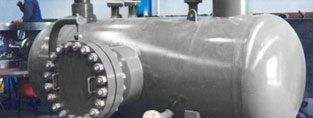
- (03) 5909 8218
- enquiry@fusionweld.com.au
Underground Gas Storage: Efficiency and Quality Requirements
October 26, 2016

Sunken gaseous resources necessitate a unique focus on equally unique variables, such as the composition of the soil and the likelihood of unforeseen subterranean site irregularities. This is because geological and geographical sciences hold sway down here, and they require almost as much consideration as any engineering problem or architectural issue. In evaluating these subterranean variables, we need to assess the efficiency and quality requirements of this below-ground scenario. That all sounds a little ambiguous, which isn't a word that should ever be allowed in an engineer's vocabulary, so details are needed.
When Local Legislation Meets Structural Design
Advanced structural shoring techniques define the outer boundaries of an underground enclosure, but much of this infrastructure is already in place below ground. Old salt mines and natural aquifers are classed as injectable gas storage sites. Likewise, previously occupied oil fields can play host to pressurized gas reservoirs, but there are certain factors that will naturally affect how well these natural storage sites can perform when the pressure rises. Thankfully, millions of years of geological action have shaped these underground chambers, so they're well-suited for this repurposing role.
Accounting for Site-Relevant Geological Factors
Rocky strata bands as it's compressed, so its characteristics change sharply at different depths. The porosity and permeability of the layers vary, so those layers require a quality assessment study before site deliverability rate can be properly established. Sedimentary samples may be required to gauge the geological and physical characteristics of a salt cavern, but depleted storage areas are usually already well understood, for they were studied when the oil or gas was first recovered.
Typical Underground gas storage sites:
- Salt Caverns
- Aquifers
- Depleted fields (Formerly occupied by hydrocarbon reserves)
Cycling an Efficient Gas Storage Facility
The reinterment of gas is a unique process, one that's quite unlike the standard oil and gas refinement techniques used today. The quality requirements for the injected gas require it to be cleaned and filtered, then, before it's injected, it's metered and inventoried, all so that the gross injected value can be compared to withdrawn quantities. Any differentials in these two values could indicate a ground permeability or porosity issue. Health and safety boards conduct exhaustive feasibility studies on each subterranean candidate before they're ever selected as a viable storage option.
In terms of legislation, geological studies are correlated with health and safety assessments before an engineering department ever cleans, meters, and injects vast quantities of pressurized gas into natural caverns or aquifers.
Contact Details
Fusion - Weld Engineering Pty Ltd
ABN 98 068 987619
1865 Frankston Flinders Road,
Hastings, VIC 3915
Ph: (03) 5909 8218
Optimized by NetwizardSEO.com.au
Recent Posts
- Compressed Hydrogen Storage Vessels: Material Selection, Design & Australian Standards
- Welding QA/QC in Oil & Gas Pressure Vessel Fabrication – Ensuring Code Compliance
- AS1210 vs ASME VIII Pressure Vessel Code: Key Differences for Australian Projects
- Mitigating Hydrogen-Induced Cracking in Pressure Vessels: Engineering and Material Strategies
- Storage Tank Solutions Australia: Field-Erected, Prefabricated & Self-Bunded Explained
- Reducing Environmental Risks: Self-Bunded Tanks in Australian Oil & Gas Operations
- Precision in Production: How Pressure Vessels Are Manufactured for Industrial Safety
- Shell & Tube Heat Exchangers: Improve Thermal Control & Energy Recovery in Petrochemical & Pharmaceutical Plants
- In-Service Inspection for Compressed Air Receivers for Power Plant Shutdown Prevention
- Power Plant Pipe Spooling Fabrication – Get Rapid, Code-Compliant Spools Ready for Installation
- Field Erected Tanks: Safe, Reliable On-Site Fuel Storage Solutions in Australia
- Custom Pressure Vessel Fabrication for Flammable Gases
Posts 2025
- Compressed Hydrogen Storage Vessels: Material Selection, Design & Australian Standards
- Welding QA/QC in Oil & Gas Pressure Vessel Fabrication – Ensuring Code Compliance
- View all articles…
Posts 2024
- Large Process Vessels: Optimising the Design for Maximum Efficiency [2025]
- Pressure Equipment Management System Installation: Detect Equipment Faults Early
- View all articles…
Posts 2023
- Pressure Piping System Inspection: A Gift of Safety for the Holidays
- Deaerator Inspections by Fusion-Weld Engineering and How They Reduce System Downtime
- View all articles…
Posts 2022
- How Fusion Weld Keeps Up With AS-NZS ISO 9001:2008 Standard
- Boiler Equipment Safety Inspection During the Summer Season
- View all articles…
Posts 2021
- Avoid These Factors and Practices that Contribute to Sealing Damage in Pressure Vessels
- Do's And Don'ts Of Industrial Boiler Inspection And Maintenance From Fusion-Weld
- View all articles…
Posts 2020
- What are the Risks and Hazards Involved in Pressure Vessel Equipment?
- How to Know if Your Pressure Equipment Needs Repair or Replacement?
- View all articles…
Posts 2019
- Factors that Contribute to Pressure Vessel Failure
- Pressure Vessel Regulations in Australia: What are the Mandatory Requirements?
- View all articles…
Posts 2018
- Pros and Cons of Spherical vs. Cylindrical Pressure Vessels
- What are the Different Hazard Levels in Pressure Vessels?
- View all articles…
Posts 2017
- Transportable Pressure Vessels: The Importance of Inspection and Safety Checks
- Fracture Mechanics and Stress Analysis of Cracks in Pressure Vessels
- View all articles…
Posts 2016
Posts 2015
- What Are Deaerators & Feedwater Vessels?
- Precautions and Safety for Compressed Air Receiver Vessels
- View all articles…
Posts 2014
- Demonstrating In-process Inspection Procedures
- Static Grounding Practices and Standards
- View all articles…